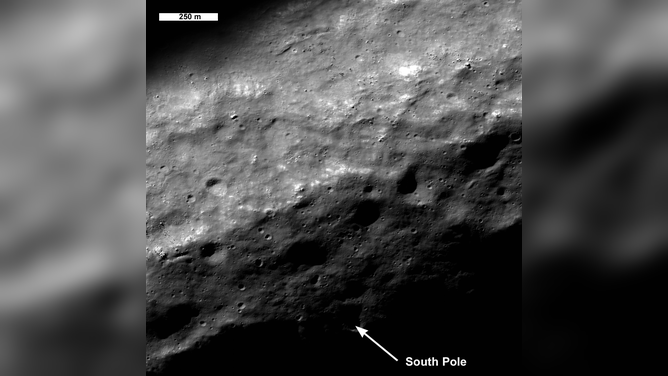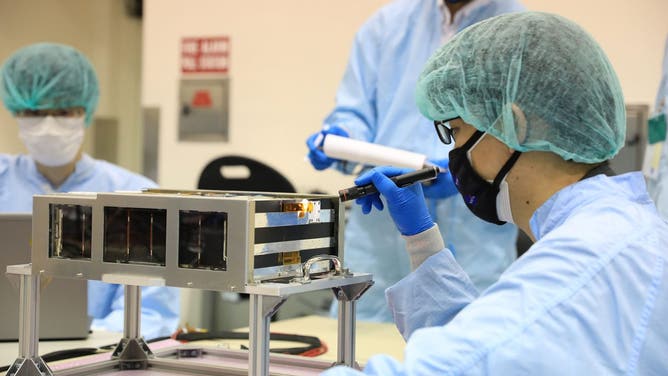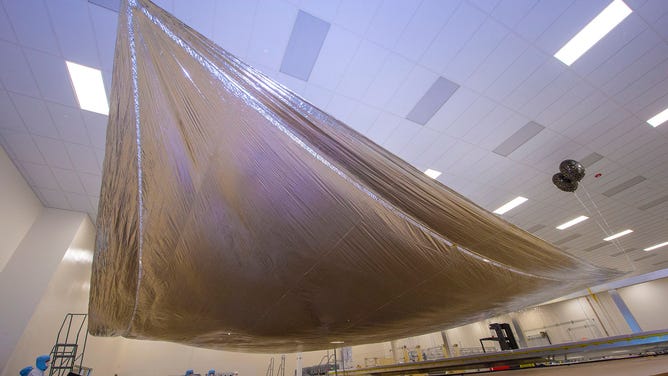Tiny spacecraft hitchhiking on NASA's Artemis-1 mission will scavenge for moon ice, test hard landing method
Ten shoebox-size spacecraft will hitchhike on NASA's Artemis-1 mission set to launch from Kennedy Space Center in late August. Each satellite is designed to advance moon exploration or other science goals.

This September 2009 image shows the moon moving into the southern summer and the region around the south pole captured by the Lunar Reconnaissance Orbiter Camera. [Image: NASA/GSFC/Arizona State University]
NASA's Space Launch System moon rocket, scheduled to launch in a few weeks from Kennedy Space Center, will set the stage for a future human moon landing and provide a ride for a fleet of tiny spacecraft hitchhikers with unique science missions.
Most of the attention ahead of the Artemis-1 mission launching on Aug. 29 is about the Orion spacecraft that will orbit the moon and the SLS, a 322-foot-tall beast of a rocket with 8.8 million pounds of thrust. But what about the little guys? While no humans will be on this maiden voyage to orbit the moon, NASA has selected 10 CubeSats going to deep space destinations that will be deployed along Orion's spaceflight.
According to NASA, each tiny satellite designed by international, industry and university partners will gather data to help future moon missions and Mars exploration. The European Space Agency, Italian Space Agency (ASI) and Japanese Space Agency (JAXA) are among the international payloads flying with Orion.
HOW TO WATCH THE ARTEMIS 1 LAUNCH ONLINE AND ON FLORIDA'S SPACE COAST
The CubeSats will be mounted in the Orion stage adapter, a ring that attaches the interim cryogenic propulsion stage (ICPS) to Orion’s spacecraft adapter. After Orion separates, the shoebox-size spacecraft will be deployed from dispensers on the adapter ring.
CubeSats are launched and deployed in low-Earth orbit all the time. NASA's Chief Exploration Scientist Jacob Bleacher explains the Artemis program will enable these lower-cost, high risk and high-reward satellites to explore further.

Members of the EQUULEUS (EQUilibriUm Lunar-Earth point 6U Spacecraft) team prepare their CubeSat to be loaded in the Space Launch System’s Orion stage adapter for launch on the Artemis I mission. (Image: NASA/JAXA)
"These CubeSats will provide new understanding of the lunar environment, which in turn will help us better design our exploration systems to help keep our crew safe and help hardware survive longer at the moon," Bleacher said in a recent call with journalists.
Just how much frozen water is on the moon is one of the critical questions as NASA plans to return humans to the moon by 2025. Ice can be harvested by astronauts and robots to be used for fuel, water and other resources instead of making supply runs.
One of those satellites, LunarH-Map, led by the Arizona State University, will create maps of craters on the moon and shadowed regions near the lunar South Pole believed to contain water ice.
"We've known for quite some time that there's water ice at the moon's poles. But there are a lot of unanswered questions about how much there is and where exactly it is," LunarH-Map principal investigator Craig Hardgrove with the Arizona State University said.
WHAT IS NASA'S ARTEMIS 1 MISSION GOING TO DO?
Most of the ice is near permanently shadowed regions of the South Pole, some of the coldest locations in the solar system because the areas never see sunlight. It's also possible that water ice could be in the sunlit plains, but there is not enough high-resolution data of both poles to know, Hardgrove said.
"On such a small spacecraft, we're able to plan the mission and navigate into a very low altitude South Pole orbit so that we can pass over these regions of the South Pole and reveal whether or not there are enrichments of ice only within the permanently shadowed regions, or if the ice actually extends out into the illuminated plains," Hardgrove said.
LunarH-Map will use a neutron spectroscopy instrument to investigate these sunlit regions.
Another spacecraft, Lunar IceCube, led by Morehead State University, will search for ice on the moon using an infrared spectrometer.
Many of these CubeSats have moon-related goals, while others focus on additional deep-space research or Earth science.
JAXA is involved in two CubeSats launching on Artemis 1, OMOTENASHI, an effort to develop the smallest lunar lander and EQUULEUS, a partnership with the University of Tokyo studying Earth's radiation environment.
Tatsuaki Hashimoto, project manager for OMOTENASHI, said the 6U CubeSat would make a semi-hard but, hopefully, survivable landing on the moon to demonstrate the technology for future missions. After an orbital insertion maneuver, OMOTENASHI will use a small rocket motor to hover at about 200 meters before making a free fall to the moon with a small airbag to soften the fall.
"The trajectory is carefully designed so as to maximize the probability of the landing success," Tatsuaki said. "The ignition timing of OMOTENASHI's rocket motor is very important."

NEA Scout sail fully deployed. (Image: NASA)
NASA's Marshall Space Flight Center is sending NEA Scout up with Artemis 1. A 925-square-foot solar sail will propel the shoebox-size spacecraft to photograph a near-Earth asteroid.
The SLS and Orion arrived at Kennedy Space Center's launchpad 39B early Wednesday ahead of the targeted Aug. 29 launch.

